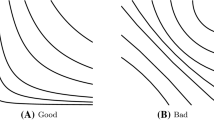Abstract
We investigate a strong maximum principle of Vázquez type for viscosity solutions of fully nonlinear and degenerate elliptic equations involving Hörmander vector fields. We also give a strong comparison principle for such equations.

Similar content being viewed by others
Notes
Du denotes the gradient of u relative to the standard canonical frame \(\{\frac{\partial }{\partial x_1},\cdots ,\frac{\partial }{\partial x_N}\}\) of \(\mathbb {R}^N\).
References
Bieske, T.: On \(\infty \)-harmonic functions on the Heisenberg group. Comm. Partial Differential Equations 27(3–4), 727–761 (2002)
Bardi, M., Da Lio, F.: Propagation of maxima and strong maximum principle for viscosity solutions of degenerate elliptic equations. I. convex operators. Nonlinear Anal. Ser. A: Theory Methods 44(8), 991–1006 (2001)
Bardi, M., Da Lio, F.: Propagation of maxima and strong maximum principle for viscosity solutions of degenerate elliptic equations. II. concave operators. Indiana Univ. Math. J. 52(3), 607–627 (2003)
Bardi, M., Goffi, A.: New strong maximum and comparison principles for fully nonlinear degenerate elliptic PDEs. Calc. Var. Partial Differential Equations 58(6), 184 (2019)
Battaglia, E., Biagi, S., Bonfiglioli, A.: The strong maximum principle and the Harnack inequality for a class of hypoelliptic non-Hörmander operators. Ann. Inst. Fourier (Grenoble) 66(2), 589–631 (2016)
Beatrous, F.H., Bieske, T.J., Manfredi, J.J.: The maximum principle for vector fields the p-harmonic equation and recent advances in analysis. Contemp. Math. Amer. Math. Soc, Providence RI (2005)
Bonfiglioli, A., Lanconelli, E., Uguzzoni, F.: Stratified lie groups and potential theory for their sub-laplacians. Springer, New York (2007)
Bony, J-M.: Principe du maximum, inégalite de Harnack et unicité du problème de Cauchy pour les opérateurs elliptiques dégénérés. (French) Ann. Inst. Fourier (Grenoble) 19 1969 fasc. 1, 277–304 xii
Caffarelli, L.A., Cabré, X.: Fully Nonlinear elliptic Equations Colloquium publications 43. American Mathematical Society, Providence (1995)
Capogna, L., Zhou, X.: Strong comparison principle for p-harmonic functions in Carnot-Caratheodory spaces. Proc. Amer. Math. Soc. 146(10), 4265–4274 (2018)
Crandall, M., Ishii, H., Lions, P.L.: User’s guide to viscosity solutions of second order partial differential equations. Bull. AMS. Soc. 27(1), 1–67 (1992)
Felmer, P., Montenegro, M., Quaas, A.: A note on the strong maximum principle and the compact support principle. J. Differential Equations 246(1), 39–49 (2009)
Manfredi, J.J.: Nonlinear subelliptic equations on Carnot groups. Notes of a course given at the third school on Analysis and Geometry in metric spaces, (2003) http://www.pitt.edu/~manfredi/papers/fullynonlsubtrentofinal.pdf
Mohammed, A., Vitolo, A.: On the strong maximum principle. Complex Var. Elliptic Equ. 65(8), 1299–1314 (2020)
Pucci, P., Serrin, J.: The maximum principle. Progress in Nonlinear Differential Equations and their Applications, 73. Birkhäuser Verlag, Basel, (2007)
Pucci, P., Serrin, J.: The strong maximum principle revisited. J. Differential Equations 196, 1–66 (2004)
Pucci, P., Serrin, J.: A note on the strong maximum principle for elliptic differential inequalities. J. Math. Pures Appl. 79, 57–71 (2000)
Pucci, P., Serrin, J., Zou, H.: A strong maximum principle and a compact support principle for singular elliptic equations. J. Math. Pures Appl. 78, 769–789 (1991)
Pucci, P., Rădulescu, V.: The maximum principle with lack of monotonicity. Electron. J. Qual. Theory Differ. Equ. 58, 11 (2018)
Vázquez, J.L.: A strong maximum principle for some quasilinear elliptic equations. Appl. Math. Optim. Equ. 12, 191–202 (1984)
Acknowledgements
The authors wish to thank the anonymous referees for reading the manuscript carefully and for their useful comments.
Author information
Authors and Affiliations
Corresponding author
Additional information
Communicated by A. Malchiodi.
Publisher's Note
Springer Nature remains neutral with regard to jurisdictional claims in published maps and institutional affiliations.
Appendix
Appendix
Let us begin by providing a proof of Remark 1.2 (ii). Let us first note that for any \( a>0,s>0\) we have
For a fixed s, we take the limit in (5.1) as \(a\rightarrow \infty \) to get
Given \(t\ge 0\), assume that the function \(s\mapsto a\omega (s)+ H(as,t)\) is non-decreasing in s for all \(a\ge a_0\ge 1\). Let \(\alpha \le \beta \). Then, by assumption, we have
Sending \(a\rightarrow \infty \), and using the limit in (5.2) we conclude that
If \(\varpi (0)=0\), then \(H(\beta , t)\ge H(\alpha ,t).\) \(\square \)
In the remainder of this appendix we provide some examples to illustrate the conditions on F and H that were used to obtain the strong maximum and comparison principles.
For \((x,p,Y)\in \Omega \times \mathbb {R}^N\times S^{m\times m},\) we set
where \(b:= (b_{ij} )\in S^{m\times m}\) satisfies
We take \(0<\lambda \le \Lambda <\infty \) and the function \(\varpi :\mathbb {R}^+_0\rightarrow \mathbb {R}^+_0\) is a non-decreasing function such that \(\varpi (t)>0\) for \(t>0\). It follows from (5.3) that F satisfies conditions (F-1) and (F-2). Thus, in this case a supersolution u of (1.7) would satisfy
where H satisfies (H-i) and (H-d). A specific example can be given by taking \(b(x,p)=|p|^\gamma I_m\) and \(H(s,t)=\max \{0,s\}^\alpha +t^\beta \), where \(\alpha ,\beta \) and \(\gamma \) are non-negative numbers. This leads to
where \(\Omega \subseteq \mathbb {R}^N\) is a connected open subset. If \(\min (\alpha , \beta )\ge \gamma +1\) and u is a non-negative viscosity solution of (5.4), then Theorem 1.8 shows that either \(u\equiv 0\) in \(\Omega \) or \(u>0\) in \(\Omega \)
We mention here that if \(b_{ij}=b_{ij}(x)\) with \(\lambda I_m\le b\le \Lambda I_m\), and \(c_i(x)\) and d(x) are continuous and bounded, the elliptic inequality
is also included in our work. To see this, define \(H(u, |D_{\mathcal {X}} u|)=M( u+|D_{\mathcal {X}} u|)\), where \(M\ge \max \{ \max |d|,\; \max _{1\le i\le m}|c_i | \}\). Thus, (5.5) may be written as
where F satisfies (F-1) and (F-2) and H satisfies (H-i) and (H-d).
Let h be a \(C^1\) function on \(\mathbb {R}_0^+\), and set
Then
Let \(\mathcal {K}\subseteq \mathbb {R}^N\times \mathbb {S}^{m\times m}\) be a given compact set. Then for all \((p, X),(q,Y)\in \mathcal {K}\) we have
where \(\kappa \) depends on \(\mathcal {K}\). See [9] for the last inequality used above.
Therefore \(F(x,p,X):=\varpi (|p|)\mathcal {M}_{\lambda ,\Lambda }^-(X)\) satisfies condition (F-2)\(^*\). Obviously, F satisfies (F-1) and (F-2).
Next we look at some examples with the goal of showing the following.
- (i):
-
If H satisfies (H-d) and (H-i) but \(s\mapsto H(s,t)\) is not monotonic non-decreasing in s for each \(t\ge 0\), then Theorem 1.8 may not hold for supersolutions u with \(\inf _\Omega u<0\). See Remark 1.9 (ii).
- (ii):
-
The strong comparison principle, Theorem 1.10, may fail if the assumption \(|Du|>0\) is not met when \(\varpi (0)=0\).
For (i), we consider \(F(x,p,X)=\text {trace}(X)\) and \(H(s,t)=\sin ^2 s+Nt^2\). Then H satisfies both (H-i) and (H-d), but \(s\mapsto H(s,t)\) is not monotonic. Let
We note that u is a sign-changing function in the ball \(B:=B\left( o,2\sqrt{5\pi N/3}\right) \) such that
Since \(F(x,Du,D^2u)=\Delta u=1/4\), we see that \(F(x,Du,D^2u)\le H(u,|Du|)\) holds in the ball B.
Let us now look at (ii). Let \(F(x,p,X)=|p|^2\,\text {trace}(X)\) and \(H(s,t)= 4N\,|t|\), where N is the dimension of \(\mathbb {R}^N\). As noted earlier, F satisfies (F-2)\(^*\) with \(\varpi (t)=t^2\). Clearly F satisfies (F-1). Note that \(u\equiv 0\) is a subsolution and \(w(x)=|x|^2\) is a supersolution of
This demonstrates the necessity of the condition \(|Du|>0\) when \(\varpi (0)=0\) in the strong comparison principle, Theorem (1.10).
Rights and permissions
About this article
Cite this article
Bhattacharya, T., Mohammed, A. On a strong maximum principle for fully nonlinear subelliptic equations with Hörmander condition. Calc. Var. 60, 9 (2021). https://doi.org/10.1007/s00526-020-01869-4
Received:
Accepted:
Published:
DOI: https://doi.org/10.1007/s00526-020-01869-4



